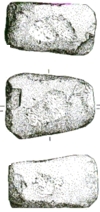


Following the ‘Great Discovery’ of 1762 for a short while Parys Mountain (the Parys and Mona Mines) was amongst the largest producers of copper in Europe.

The Great Opencast (Parys Mine) today, Carreg y ddol windmill for scale.
Photo copyright D.Jenkins
The earliest reference to finds of hammer stones, ancient workings and the remains of brushwood fires at the top of the mountain (within an area since lost to collapse inside of the Great Opencast) is to be found within the ‘Journal of a Tour in Wales 1796’ by Christopher Sykes of Sledmere, Yorks.
In 1937 Oliver Davies investigated old workings within the area of the windmill,
and identified ancient tips with hammer stones and charcoal just to the north of
here close to the site of the Oxen Quarry (Chwarel yr Eigion). Davies’ trench was
re-
Access was made available to cavers to examine the 19th century underground workings via. the Parys Footway Shaft in 1995. Following this, two more areas of Early Bronze Age mining became accessible within slope workings leading off from the 16 and 20 fathom levels. Four underground sections have now been recorded by David Jenkins and a further ten Early Bronze Age radiocarbon dates plus some important environmental evidence have been obtained from a number of them. (Jenkins 2003).
It seems possible that the prehistoric miners sunk inclined drifts or open trenches to a depth of up to 100 feet from surface in order to extract the copper ore.
Underground survey work has been carried out by Dr. David Jenkins on the underground on the North Discovery Lode, identifying several sites of prehistoric mining.
This website was made possible by a grant from the Cambrian Archaeology Association


Mine survey, showing location of early workings. (D. Jenkins)
Photograph of David Jenkins at one of the sites of
prehistoric mining underground